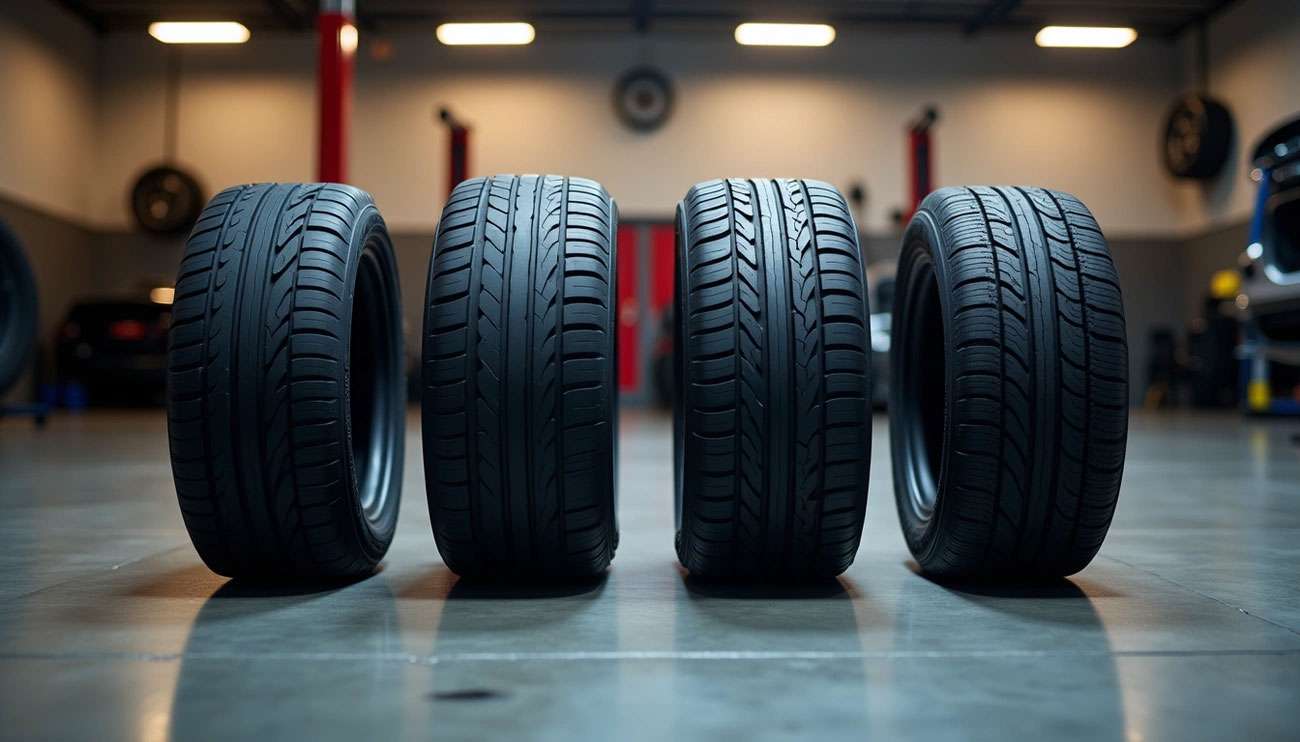
Shopping for tires becomes overwhelming fast when you discover tire cost ranges from $50 to over $1,000 per tire. That's an enormous price spread for what appears to be a simple purchase!
The average cost for a complete set of four new tires runs between $460 and $1,280. Prices keep climbing each year too. Consumer Reports tracked the median price jumping from $167 per tire in 2020 to $223 in 2023. Installation costs climbed from $25 to $31 per tire during that same period.
We understand that knowing what drives tire prices helps you make smarter buying decisions. The cost depends heavily on factors like your driving terrain and local weather conditions. We'll break down the hidden factors that determine what you should pay for quality tires, helping you find the perfect balance between performance and value.
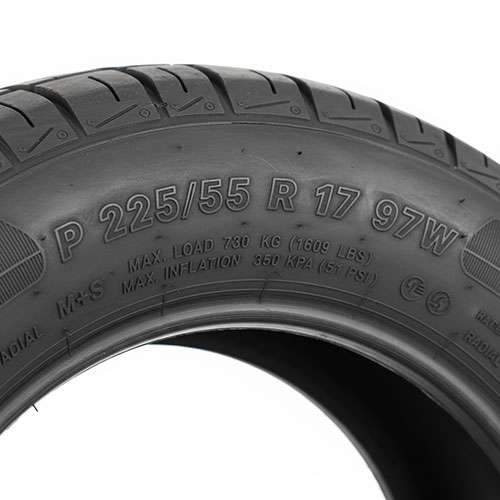
When it comes to tire pricing, type and size work hand-in-hand to determine your final cost at checkout. These two factors create the biggest price variations you'll encounter during tire shopping.
Understanding how these elements interact helps you plan your tire budget effectively and avoid sticker shock at the register.
Tire pricing follows clear patterns based on quality tiers and sizing requirements. Budget-friendly options typically range from $50 to $150 per tire, while mid-range tires cost between $100 and $300 each. Premium tires command anywhere from $150 to over $1,000 per tire.
The tire type you choose dramatically impacts your final cost. All-season and summer tires offer the most economical choices, especially in smaller sizes. Winter tires and all-terrain options cost more due to their specialized construction and advanced rubber compounds. Performance tires designed for sports cars and high-speed driving typically cost the most, reflecting their sophisticated engineering and premium materials.
Quality tiers directly correlate with pricing:
Specialized tires designed for electric vehicles cost significantly more than standard options due to reinforced construction that accommodates increased vehicle weight.
Tire size stands as one of the most significant cost drivers in tire selection. Larger tires demand more raw materials including rubber, steel, and specialized compounds, directly increasing manufacturing expenses.
The tire size designation system (like 215/55/17) indicates three critical measurements:
When any of these numbers increase, particularly the wheel diameter, prices climb accordingly. Larger diameter wheels require tires with bigger overall dimensions but often shorter sidewalls, demanding additional reinforcement to maintain strength and performance.
Size categories break down into clear pricing tiers:
Even comparing tires with similar overall diameter, those requiring larger wheel diameters (lower-profile sidewalls) consistently cost more. A tire fitting a 19" wheel often costs nearly double that of a 16" wheel tire with identical overall diameter.
This price difference stems from manufacturing challenges in creating reinforced sidewalls for lower-profile tires and the specialized rubber compounds required. Less sidewall rubber means more engineering to maintain strength and performance capabilities.
Different vehicle types require specific tire sizes and constructions, creating predictable pricing patterns across categories. Understanding these patterns helps establish realistic budgets for your tire replacement.
Compact cars and small sedans:
Mid-size sedans and small SUVs:
Large SUVs and trucks:
Performance and specialized vehicles require the most expensive tires. Sports cars using high-performance tires can expect costs from $200-$400+ per tire, while off-road vehicles using all-terrain tires typically range from $100-$400 per tire depending on size.
Performance Plus Tire offers extensive selection tools that match the right tire type and size to your specific vehicle, driving conditions, and budget requirements.
Electric vehicles present unique challenges - their increased weight requires specialized tires costing considerably more than conventional options. These tires feature reinforced construction and specific rubber compounds engineered to handle instant torque delivery and battery weight.
The relationship between tire size and vehicle type explains why replacing tires on larger vehicles costs significantly more. Understanding your vehicle's specific requirements prevents unexpected expenses at replacement time.
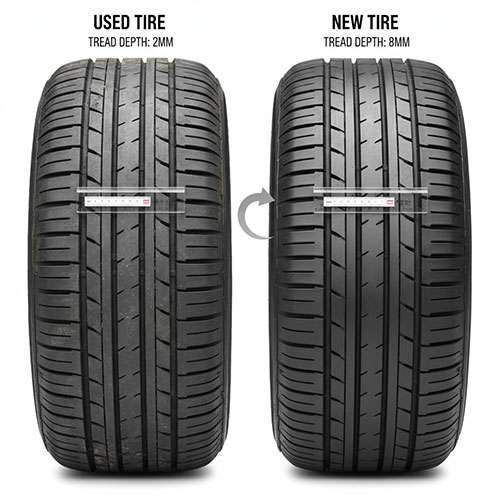
Treadwear ratings determine your tire's lifespan and your long-term costs. Understanding these ratings is essential before making any tire purchase decision. Treadwear directly controls how many miles you'll get from your investment and how often you'll need replacements.
Understanding treadwear ratings matters just as much as knowing the right size when shopping for tires. Treadwear directly affects how long your tires last and what they'll actually cost you over time.
Treadwear rating works as a comparative index that shows a tire's expected lifespan compared to a reference tire. The US Department of Transportation created this system in the 1970s to help consumers make sense of tire shopping. You'll find this rating as a three-digit number on the tire's sidewall alongside other required information.
The baseline comparison uses a reference tire with a rating of 100. A tire with a treadwear rating of 200 should last twice as long as the reference tire, while one with 400 should last four times longer. The highest treadwear rating available today is 860, found on certain touring all-season tires.
These numbers don't translate directly to mileage though. They represent how well the tire performed against the control tire in standardized tests where manufacturers drive tires 7,200 miles on a specified government test track.
Manufacturers assign these ratings themselves after testing their products against the reference standard. This self-reporting system means treadwear ratings work best when comparing tires within the same brand rather than across different manufacturers.
Different tire types fall within specific treadwear rating ranges:
Most tires need replacement when tread depth reaches 2/32 inches. You can check this using the penny test - if Lincoln's head shows completely when inserted into the tread, it's time for new tires.
The real cost of a tire goes far beyond its purchase price. Longevity plays a crucial role in determining overall value. Tires with higher treadwear ratings typically cost more upfront, yet they often deliver better cost-per-mile value over their lifespan.
Premium tires with enhanced durability might cover significantly more miles before requiring replacement, potentially making them more economical long-term despite their higher initial investment. Budget tires with lower treadwear ratings may need replacement more frequently, eventually erasing any initial savings.
Tire manufacturers often provide treadwear warranties expressed in miles, typically ranging between 50,000 and 90,000 miles for all-season tires. These warranties can be misleading though. If your tires wear out prematurely, you'll likely receive only partial credit toward new tires from the same manufacturer - calculated against often-inflated manufacturer suggested retail prices, not the discounted prices most retailers offer.
Several factors influence how quickly your tires wear out, regardless of their treadwear rating:
Even expensive tires with high treadwear ratings might not outlast budget options if poorly maintained. Regular tire rotation every 5,000 to 7,000 miles ensures even wear distribution, while proper inflation is essential for maximizing tire lifespan.
Selecting tires means facing a fundamental trade-off: grip versus longevity. This represents one of the most important considerations in tire economics and performance.
Tires with higher treadwear ratings (500-700+) typically feature harder rubber compounds that resist wear but provide less grip on road surfaces. These tires excel at delivering consistent, long-lasting performance for everyday driving and offer better fuel economy through reduced rolling resistance.
Performance-oriented tires with lower treadwear ratings (often 200-350) utilize softer rubber compounds that conform better to road surfaces, providing superior traction in both dry and wet conditions. This enhanced grip comes at the expense of more rapid wear.
Racing and high-performance tires with extremely low treadwear ratings (below 200) sacrifice longevity entirely for maximum grip. These specialized tires use ultra-soft compounds that deliver exceptional handling and cornering abilities but wear out rapidly.
Choosing tires with excellent grip typically means replacing them more frequently. Performance tires with a 200 treadwear rating on a daily-driven car might last only about a year before requiring replacement, provided temperatures stay above 45 degrees Fahrenheit.
This performance-longevity balance explains why tire pricing varies substantially even within the same size category. A high-performance tire with superior grip capabilities often costs more than a basic all-season tire of identical dimensions - yet might deliver fewer total miles of service.
When considering tire costs, evaluate not just the initial price tag but also how the treadwear rating aligns with your driving needs. Highway commuters seeking value might prioritize higher treadwear ratings, while enthusiasts who appreciate responsive handling might willingly accept the higher long-term costs associated with grippier, shorter-lived tires.
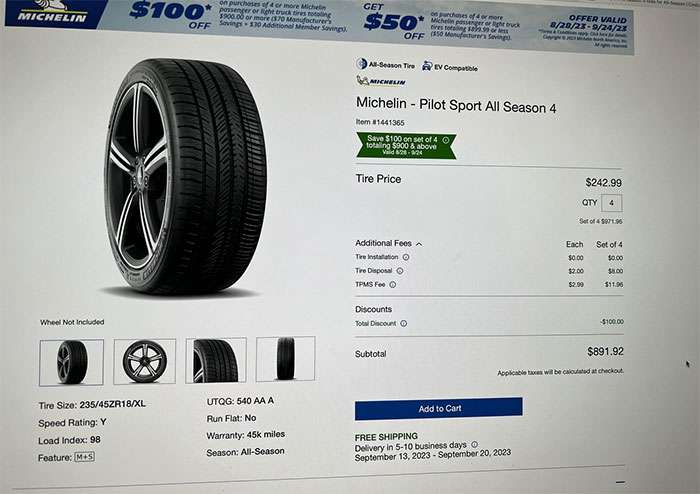
Image Source: Reddit
Installation fees represent one of the biggest surprises in tire shopping - costs that many drivers never see coming. These service charges add $60 to $200 to your total bill for a set of four tires, turning what seemed like a straightforward purchase into a much larger expense.
The tire price you see advertised rarely tells the complete story. What appears to be a great deal on the rubber itself can quickly become expensive once you factor in the mounting, balancing, and disposal fees that shops add at checkout.
Mounting a tire costs between $15 and $50 per tire, with the average around $22 per tire for mounting and balancing combined. A complete set of four tires typically requires $60 to $200 for professional installation. This wide variation depends on several factors:
What does this installation fee cover? According to Discount Tire, typical installation costs include:
The base installation price at chain stores averages $17 per tire, but this rate often grows substantially once additional services are added.
Beyond the base installation fee, numerous additional charges can inflate your final bill considerably. One study found that a shop's advertised base rate of $17 per tire jumped to $28 once all fees were included, increasing the total cost for four tires to $112.
Common hidden charges include:
Road hazard warranties deserve careful scrutiny. Even with coverage, you might still face charges for installation ($29), disposal fees, and potentially even a new warranty fee ($19) when claiming a replacement. According to Edmunds.com, while road hazard warranties help avoid the full $150-200 cost of a new tire, replacements rarely end up completely free.
Here's a practical example: four tires initially priced at $600 might require an additional $88 for mounting and balancing, plus $16 for disposal fees, pushing your final bill to $704 - not including optional TPMS service or road hazard protection.
Given these substantial additional costs, you can employ several strategies to minimize installation expenses:
Compare total "out-the-door" prices: Request quotes that include all fees and services rather than just the base installation rate. This prevents surprise charges at checkout. Some shops like Pep Boys charge a higher upfront installation fee ($30) but include all services with no hidden fees, potentially saving money compared to places with lower advertised rates.
Seek bundled services: Many retailers offer free installation when you purchase tires directly from them. Walmart provides the lowest overall installation prices when you buy their tires.
Look for lifetime benefits: Certain packages include significant long-term value through:
Time your purchase strategically: Start shopping before you urgently need tires, allowing time to:
Consider warehouse clubs: Sam's Club and Costco typically offer excellent value, combining low installation prices with comprehensive services and roadside assistance programs.
The smartest approach balances upfront savings against long-term value. A seemingly higher installation price might prove economical if it includes free rotation services that would otherwise cost over $100 annually. Comprehensive maintenance packages that include installation, balancing, and other essential services often deliver superior value compared to paying for these services individually.
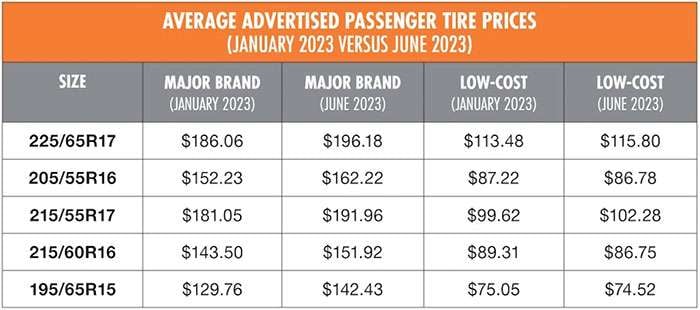
Image Source: Modern Tire Dealer
Brand selection drives tire pricing more than most people realize. The gap between budget and premium brands creates larger price differences than size or type variations alone. Your brand choice affects both what you pay upfront and the value you get over time.
Brand names create the biggest price differences in tires - often more than size or type combined. The gap between budget options and premium brands affects your wallet now and your driving experience for years to come.
Budget tire sets run between $200 and $400 for four tires, making them appealing when you need to stretch your dollars. Premium options start around $800 for a complete set.
The price difference shows up in real-world performance. When tested head-to-head against Michelin's Alpin 6, the budget-friendly Zeetex WH 1000 needed 42.3 meters to stop versus Michelin's 36.2 meters in wet conditions. That extra 6.1 meters of stopping distance could mean the difference between a close call and an accident.
Durability tells an even bigger story. Premium tires regularly deliver 70,000 to 85,000 miles of service, with top Michelin models reaching 85,000 miles in Consumer Reports testing. Budget options often wear out after just 20,000 to 30,000 miles.
Here's where the math gets interesting. Budget tires at $400 lasting 30,000 miles cost about 1.3 cents per mile. Premium tires at $800 lasting 70,000 miles cost roughly 1.1 cents per mile - making the expensive tires actually cheaper over time. Check out Performance Plus Tire for detailed comparisons between premium and budget options to find your ideal balance of upfront cost and long-term value.
Premium manufacturers back their products with treadwear warranties spanning 40,000 to 80,000 miles, plus road hazard protection and manufacturing defect coverage. Budget brands typically offer only basic manufacturing defect protection.
Performance tires occupy their own pricing category because they prioritize handling and speed over longevity and comfort.
Performance tire categories follow predictable price structures:
The ultimate performance options like Michelin Pilot Sport 3 can hit $600 per tire. These premium choices use cutting-edge materials and technology to deliver exceptional grip and handling.
Performance tires cost more because they're built differently. They feature higher-grade components, reinforced rubber compounds, and advanced polymers that improve durability and performance. Sophisticated tread designs optimized for specific performance characteristics add to their premium pricing.
Performance tires also start with greater tread depth than budget alternatives, providing more rubber to wear away while maintaining handling characteristics. More rubber means higher manufacturing costs.
The tire industry breaks down into distinct tiers that help set realistic price expectations:
Tier One (Premium Brands): Michelin, Bridgestone, Continental, and Goodyear represent the top tier. These brands command premium prices but deliver the most advanced technology and longest warranties.
Tier Two (Mid-Market Brands): Pirelli, Firestone, Toyo, Yokohama, Cooper, General, Hankook, Dunlop, Nitto, Uniroyal, and Kumho balance quality with affordability. They offer solid performance without the marketing costs of Tier One brands.
Tier Three (Value Brands): Falken, Kelly, Nexen, Sumitomo, Nokian, and others target price-conscious buyers. These brands typically operate on lower profit margins.
Quality budget options like Achilles, Atturo, Federal, General, Ironman, Mastercraft, Milestar, and Nexen deliver reasonable performance at affordable prices. They cost significantly less than premium brands while maintaining adequate safety standards for everyday driving.
Several budget brands strike an excellent balance between immediate affordability and acceptable performance. However, you must weigh initial cost savings against potential reductions in longevity, performance, and warranty protection.
Reasonable pricing depends on your specific driving needs. Daily commuters often find the best value in mid-tier options, while performance enthusiasts might justify premium prices for superior handling characteristics.
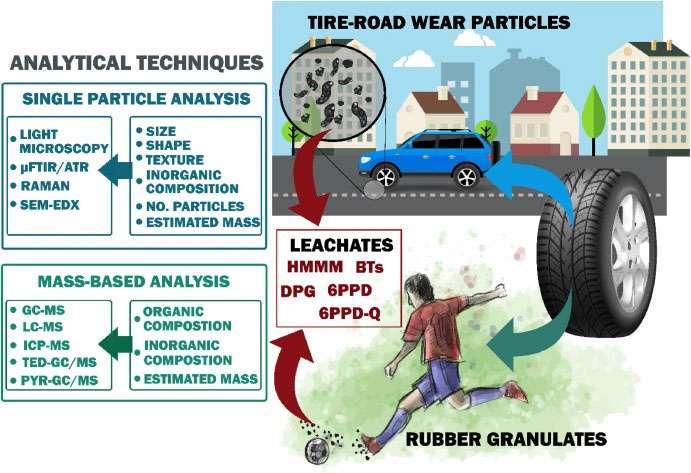
Image Source: ScienceDirect.com
Your local climate directly impacts both tire selection and your total tire budget. Different weather conditions require specific tire characteristics that can double your tire investment when you need multiple sets for extreme seasons.
Your local climate plays a major role in both tire selection and what you'll spend over time. Weather conditions often require specialized tire options that can dramatically change your total ownership costs.
Temperature patterns in your area directly impact tire performance and how long they last. When temperatures consistently drop below 45°F (7°C), standard tire rubber compounds start to harden, reducing traction and safety. This stiffening cuts grip on road surfaces and can extend braking distances.
Extreme heat creates different problems. Once temperatures climb above 100°F, tire pressure increases naturally and can lead to overinflation. Too much pressure speeds up tread wear and raises blowout risks.
Other environmental factors affect tire performance too:
These weather challenges often mean you need specialized tires for specific conditions. That directly affects what you should expect to pay for tires in your region.
Specialized seasonal tires come with different price tags:
Winter tires typically start between $50 and $100 per tire, with premium options costing much more. These specialized tires have deeper tread patterns with numerous sipes (tiny slits) that improve grip on snow and ice.
Summer tires work best for warm-weather performance and handle better on dry and wet roads when temperatures stay above 45°F. Pricing varies significantly based on performance level, with high-performance versions commanding premium prices.
All-season tires offer the most economical choice for drivers in moderate climates with temperatures from -10°C to +30°C (14°F to 86°F). Their versatile design works year-round in regions without extreme winters or summers, eliminating seasonal tire change expenses.
The choice between buying separate seasonal sets versus all-weather tires involves complex cost calculations. Buying separate winter and summer sets doubles your initial tire expense, but this approach can save money in regions with extreme conditions.
Weather conditions significantly affect how quickly you'll need new tires. Driving in poor conditions—ice, snow, and rain—accelerates tire wear because tires work harder to maintain traction.
Temperature swings between day and night impact tire pressure, affecting performance, safety, and fuel efficiency. These pressure changes create uneven wear patterns that reduce overall tire life.
Extreme conditions create additional replacement needs:
Your local climate determines not just what tires you need, but how often you'll replace them. Drivers in regions with harsh winters or extremely hot summers need tire replacements more frequently than those in moderate climates—an important factor when calculating true tire ownership costs.
Understanding these seasonal factors helps explain why proper tire selection based on your specific climate conditions represents a crucial safety investment rather than an optional expense.
| Factor | Price Range | Key Variables | Notable Characteristics | Impact on Overall Cost |
|---|---|---|---|---|
| Tire Type & Size | Small (13"-18"): $50-$150/tire Medium (19"-22"): $100-$300/tire Large (22"-26"): $140-$500+/tire |
Wheel diameter Vehicle type Tire width Sidewall ratio |
Budget: $50-$150 Mid-range: $100-$300 Premium: $150-$1,000+ |
Larger sizes and specialized types (EV, performance) dramatically increase costs |
| Treadwear & Longevity | Varies by rating: Touring: 140-860 Performance: 30-500 All-terrain: 320-680 |
Treadwear rating Driving conditions Maintenance habits Climate exposure |
Higher ratings last longer Performance tires wear faster Warranties: 50,000-90,000 miles |
Better treadwear ratings cost more initially but deliver superior cost-per-mile value |
| Installation & Service | Base: $15-$50 per tire Total: $60-$200 for set |
Service provider type Vehicle specifications Additional services Hidden charges |
Mounting and balancing TPMS service kits Disposal fees Road hazard warranties |
Hidden charges add 20-40% to base installation costs |
| Brand & Performance Tier | Tier 1 (Premium): $800+ per set Tier 2 (Mid): $400-$800 Tier 3 (Budget): $200-$400 |
Brand reputation Technology level Warranty coverage Performance capabilities |
Premium: 70,000-85,000 mile life Budget: 20,000-30,000 mile life Warranty protection varies |
Premium brands cost more upfront but often provide better long-term value |
| Seasonal & Environmental | Winter: $50-$100+ per tire All-season: Variable pricing Summer: Performance-dependent |
Local climate patterns Temperature ranges Road conditions Weather exposure |
Temperature affects performance Chemical exposure accelerates wear Seasonal wear patterns Replacement frequency varies |
Extreme climates may require multiple tire sets, doubling your investment |
Finding quality tires at the right price comes down to understanding what drives those costs. Prices vary from $50 to over $1,000 per tire for good reasons - size, type, treadwear ratings, brand quality, and seasonal requirements all play crucial roles in determining value.
Larger diameter wheels demand more expensive tires, while treadwear ratings reveal the true long-term value. Higher-rated tires cost more initially but often deliver better cost-per-mile performance through extended service life.
Installation costs can boost your total bill by 20-40%, so always request complete "out-the-door" pricing when comparing options. Brand tiers create significant price differences, with premium manufacturers providing advanced technology and extended warranties that often justify their higher prices through superior durability.
What constitutes a "good" tire cost depends entirely on your specific vehicle, driving conditions, and performance requirements. At Performance Plus Tire, we help you explore options that deliver the ideal balance of quality and value for your particular needs.
The cheapest tire rarely offers the best value. Your local weather conditions, driving habits, and vehicle specifications all matter when making your selection. Treat tire purchases as investments in safety and performance rather than simple expenses. Focus on finding the right balance between upfront cost and long-term value to maximize every mile driven, regardless of your budget.
Understanding tire costs goes beyond the sticker price - multiple hidden factors significantly impact your total investment and long-term value.
The smartest approach treats tire purchases as investments rather than expenses, focusing on total cost of ownership rather than just initial price to maximize safety and value.
The average cost for a set of four new tires typically falls between $460 and $1,280. However, prices can vary significantly based on factors like tire size, brand, and performance level.
Tire size has a major impact on cost. Generally, as the tire size increases, especially the wheel diameter, so does the price. For example, tires for 13"-18" wheels are usually the most affordable, while those for 22"-26" wheels can be significantly more expensive.
Premium brand tires often justify their higher cost through superior longevity, performance, and warranty coverage. While they have a higher upfront cost, they may offer better value over time due to longer tread life and better overall performance.
Tire installation costs typically range from $60 to $200 for a set of four tires. This includes mounting, balancing, and sometimes additional services. However, be aware of potential hidden charges that can increase the final bill.
The need for seasonal tires depends on your local climate. If you experience extreme winters with temperatures consistently below 45°F (7°C), winter tires can significantly improve safety and performance. In moderate climates, all-season tires may be sufficient year-round.